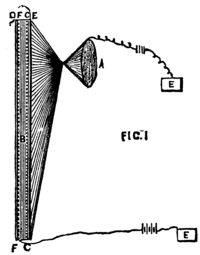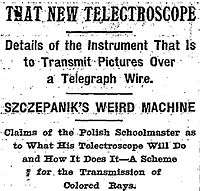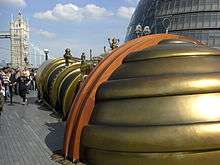Telectroscope
The telectroscope (also referred to as 'electroscope') was the first conceptual model of a television or videophone system. The term was used in the 19th century to describe science-based systems of distant seeing.

The name and its concept came into being not long after the telephone was patented in 1876, and its original concept evolved from that of remote facsimile reproductions onto paper, into the live viewing of remote images.[1]
Figuier's imaginary telectroscope

The term "telectroscope" was used by the French writer and publisher Louis Figuier in 1878 to popularize an invention wrongly interpreted as real and incorrectly ascribed to Alexander Graham Bell.[2][3] Figuier was probably misled by the article "The Electroscope" published in The New York Sun of 30 March 1877.[1][4] Written under the pseudonym "Electrician", the New York Sun article claimed that "an eminent scientist", whose name had to be withheld, had invented a device whereby objects or people anywhere in the world "could be seen anywhere by anybody". According to the article, the device would allow merchants to transmit pictures of their wares to their customers, the contents of museum collections would be made available to scholars in distant cities, and (combined with the telephone) operas and plays could be broadcast into people's homes.[5]
In reality, the imagined "telectroscopes" described in the articles had nothing to do with the device being developed by Dr. Bell and his assistant Charles Sumner Tainter which was christened with the ambiguous name photophone. The photophone was actually a wireless optical telephone that conveyed audio conversations on modulated lightbeams, the precursor for today's fiber-optic communications. Bell and Tainter would receive several patents in 1880/1881 for their then cutting-edge invention (master U.S. Patent 235,199), which used the same selenium materials in its receivers that created the initial excitement surrounding the telectroscope's proposals.[1][6]
Further developments

Nevertheless, the word "telectroscope" was widely accepted. It was used to describe the work of nineteenth century inventors and scientists such as Constantin Senlecq,[7][8] George R. Carey,[9][10][11] Adriano de Paiva,[12] and later Jan Szczepanik, who with Ludwig Kleiberg obtained a British patent (patent nr. 5031)[13] for his device in 1897.[14][15][16] Szczepanik's telectroscope, although never actually exhibited and, as some claim, likely never existed,[17] was covered in the New York Times on April 3, 1898, where it was described as "a scheme for the transmission of colored rays".[18] and it was further developed and presented on the exhibition in Paris in 1900.[19] Szczepanik's experiments fascinated Mark Twain, who wrote a fictional account of his work in his short story From The Times of 1904.[20] Both the imagined "telectroscope" of 1877 and Mark Twain's fictional device (called a telectrophonoscope) had an important effect on the public. They also provided feedback to the researchers.
Neither the fictional nor the real nineteenth century prototype telectroscopes were real television systems. "Telectroscope" was eventually replaced by the term "television", most probably coined by Constantin Perskyi in 1900.

The Telectroscope art installation
In the recent era, 'telectroscope' was the name of a modern art installation constructed by Paul St George in 2008, which provided a visual link between London and New York City.[21] In May–June 2008, artist Paul St George exhibited outdoor interactive video installations linking London and New York City as a fanciful telectroscope. According to the Telectroscope's back story, it used a transatlantic tunnel started by the artist's fictional great-grandfather, Alexander Stanhope St. George.[22][23][24] In reality, the installation used two video cameras linked by a VPN connection to provide a virtual tunnel across the Atlantic. The connection used links of between 8 and 50 Mbit/s and the images were transmitted using MPEG-2 compression.[25] The producer of this spectacle was the creative company Artichoke, who previously staged The Sultan's Elephant in London.[26]

The concept of visually linking distant places and continents in real time was previously explored by Kit Galloway and Sherrie Rabinovitz with Hole in Space (1980), an art installation linking shop windows in New York and Los Angeles[27] as well as by Maurice Benayoun with The Tunnel under the Atlantic between the Pompidou Centre in Paris and the Museum of Contemporary Art in Montreal (1995).
References
- Brian, Winston (1986). Misunderstanding media. London: Routledge & Kegan Paul. pp. 41–43. ISBN 0710200021. OCLC 15222064.
- Lange, André. "L'attribution imaginaire de l'invention du télectroscope à Graham Bell par Louis Figuier". Histoire de la télévision (in French). Retrieved Nov 8, 2018.
- Figuier, Louis (1878). "Le télectroscope, ou appareil pour transmettre à distance des images". L'Année Scientifique et Industrielle. 21 (6): 80–81.
- Lange, André. "L'histoire de la télévision commence par un canular: l'électroscope de 1877". Histoire de la télévision (in French). Retrieved Nov 8, 2018.
- "The Electroscope". The New York Sun. 44 (211). Mar 30, 1877. p. 2. ISSN 1940-7831. Retrieved Nov 8, 2018 – via Library of Congress.
- Kay, C. Mary (2007). Alexander Graham Bell: giving voice to the world. Sterling Biographies. New York: Sterling Publishing Company, Inc. pp. 76–78. ISBN 9781402749513. OCLC 80917635.
- "A Novel and Curious Instrument - The Telectroscope". Scientific American. 40 (10): 143. Mar 8, 1879. JSTOR 26063930.
- Lange, André. "A novel and curious instrument. The Telectroscope". Histoire de la télévision (in French). Retrieved Nov 8, 2018.
- Carey, George R. (June 1, 1880). "Seeing by Telegraph". The Operator. p. 3. Retrieved Nov 8, 2018 – via Histoire de la télévision.
- Carey, George R. (June 5, 1880). "Seeing by electricity". Scientific American. 42: 355 – via Histoire de la télévision.
- George R. Carey, "Transmitting, Recording and Seeing Pictures by Electricity", The Electrical Engineer, Jan. 16, 1895, pp.57-58.
- de Paiva, Adriano (1879). "A telescopia electrica". O Instituto. Revista scientifica e litteraria. 27 – via Histoire de la télévision.
- Polska. Zarys encyklopedyczny. Warsaw: PWN. 1974.
- Information about a British patent on the telectroscope for Jan Szczepanik and Ludwig Kleiberg
- "Der Fernseher (Telelekstroskop)", Die Reichswehr, Vienna, 9 March 1898, n°1466, p.5.
- Kraska, Monika (2009). Jan Szczepanik czyli polski Edison (PDF) (in Polish). Wrocław: Wrocław University.
- Shiers, George; Shiers, May (1997). Early television: a bibliographic guide to 1940. New York: Garland Pub. p. 25. ISBN 0824077822. OCLC 34604316.
- Horowitz, Johannes (April 3, 1898). "That New Telectroscope". The New York Times. p. 22. Retrieved Nov 8, 2018.
- Łepkowski, Tadeusz (1973). Słownik historii Polski (in Polish). Warszawa: Wiedza Powszechna. OCLC 879373.
- Digitized copy of Mark Twain's From The Times of 1904 from the Cornell University Library. Retrieved 26 May 2008.
- Price, Matthew (May 23, 2008). "'Tunnel' links New York to London". BBC News. Retrieved Nov 8, 2018.
- Ryzik, Melena (May 21, 2008). "A Telescope Stretches From Brooklyn to London". The New York Times. Retrieved Nov 8, 2018.
- "Optical device connects NY, London in real time". Associated Press. May 23, 2008. Archived from the original on May 28, 2008.
- Todd, Michael (May 23, 2008). "Telectroscope Invention Links New York To London". eFluxMedia. Archived from the original on April 1, 2009.
- 2thefore (June 16, 2008). "Tiscali helps artist realise extraordinary 'tunnel vision'". ResponseSource Ltd. Retrieved Nov 8, 2018.
- Clapp, Susannah (May 25, 2008). "You could really get sucked in..." The Guardian. London. Retrieved Nov 8, 2018.
- Lovejoy, Margot (2004). Digital currents: art in the electronic age (3rd expanded ed.). New York: Routledge. pp. 232–234. ISBN 0203005279. OCLC 56629968.
External links
| Wikimedia Commons has media related to Telectroscope. |